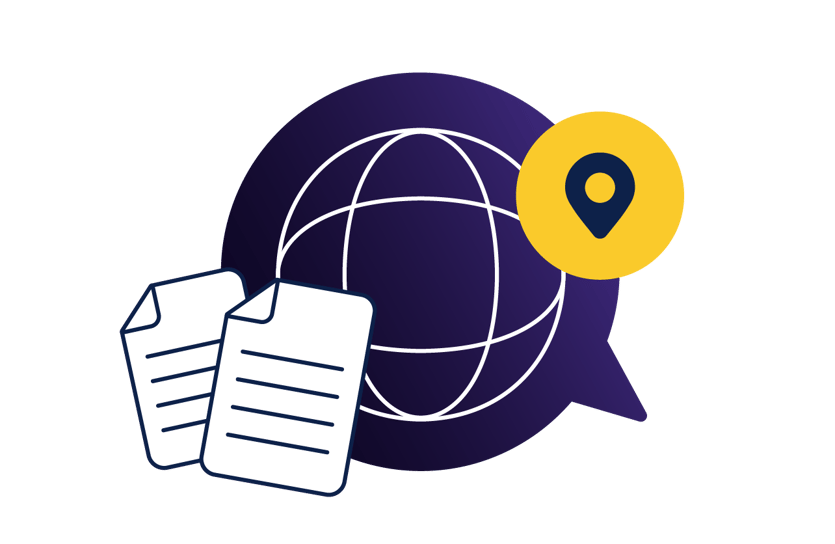Are you thinking about expanding abroad? If you’re at this stage in your business journey, one of the things you’ll need to focus on is data localization. That applies no matter what field you’re in or what line of work you do.
In this article, we look at what it means and why it matters. We also explore a few of the more common models for data localization laws and best practices for making sure you stay compliant.
What is Data Localization?
Any business thinking about moving into new markets will need to address a number of localization challenges. These might include everything from brand localization to rethinking pricing models.
All of these issues are important, and none should be overlooked—but data localization is one of the few considerations where there’s absolutely no room for mistakes.
That’s because, unlike many other elements of the localization process, data localization is a legal requirement in many jurisdictions. It refers to compliance with the laws surrounding how data is stored and/or processed within a particular country.
Video dubbing companies, for example, must ensure that they comply with data localization laws in the countries where they operate to avoid any legal penalties.
Why Do Data Localization Laws Exist?
As the amount of data generated globally has grown, we’ve seen more and more countries institute these kinds of laws. The underlying focus can vary, but exercising some form of control over cross-border data transfer is becoming ever more common.
Governments do this for a number of reasons, including:
- To ensure businesses comply with data protection laws. Implementing specific data localization laws creates a framework within which it’s difficult for organizations to operate in a non-compliant way.
- To simplify surveillance. Some governments prefer to be able to intercept their citizens’ data more easily.
- To promote local data use. Businesses may be more likely to use local data storage and processing facilities if transferring data outside of the country is restricted.
- To make it easier for police and security services to access data. If data is held within the country, it’s easier to force those storing it to hand it over.
- To safeguard against sanctions. If there’s the possibility that a country may be subject to international sanctions, its government may prefer data to be stored locally so it’s difficult for hostile regions to cut off access to digital tools.
It wouldn’t be surprising to find a snowballing of data localization laws among 2023’s top technology predictions. They can already be found, in one form or another, across the globe.
Let’s look at a couple of examples.
Examples of Data Localization Laws
The precise details of these laws vary from country to country depending on their purpose. In this section, we’ll look at two examples: GDPR in the EU and the more fragmented legal situation in China.
European Union – GDPR
The General Data Protection Regulation (GDPR) sets out how companies should process personal data. It applies not only to companies within the EU but to any organization doing business in an EU country.
The GDPR defines a number of responsibilities for those handling data and assigns rights to individuals regarding the use of their data. It gives regulators the right to hold organizations accountable and impose fines for non-compliance.
Personal data may only be collected for a defined purpose, not held “just in case”. The rules set out six situations where this is justified:
- Where consent has been given by the individual whose data is collected
- For the implementation of a contract
- A legal obligation
- In the vital interest of the data subject or another individual
- If the data is to be used for a clear public-interest case
- For the legitimate interest of the data controller
International business strategies often rely heavily on the availability of different types of customer data, so it’s crucial to understand how these rules affect your operations.
Note that it’s permitted to hold on to customer data for as long as it takes to complete a contract but not necessarily afterward, depending on the circumstances.
China – A Basket of Localization Measures
Doing business in China can be very rewarding. After all, it’s one of the largest markets on the planet and represents a superb opportunity for many organizations. However, it’s important to have a good grasp of the political environment you’ll be operating in, as this affects how the legal framework is implemented.
China’s data localization regulation is spread across a number of different laws. The main ones are the Cybersecurity Law (CSL) and the Data Security Law (DSL).
According to article 37 of the CSL, so-called critical information infrastructure operators (CIIOs) are obliged to store personal information and important data generated from critical information infrastructures in China.
The definition of “personal data” in this context is anything that could be used to identify a person—for example, names or phone numbers. Unfortunately, the definition of “important data” is not specified precisely, which can pose challenges for businesses.
Nevertheless, the data regulation landscape is changing all the time. The government’s need to balance consumer safety and social control with a pragmatic approach to the realities of international trade makes it all but inevitable that we’ll see more revisions in the near future.
Types of Data Localization Regulation
When you’re launching an overseas operation, there’s a lot to think about. Everything from your top-level marketing strategies to granular decisions, like whether to use the PySpark API in your tech stack, can be up for review.
But getting a handle on the environment you’ll be operating in is the priority, because this will affect all other decisions.
When it comes to data localization rules, it’s vital to understand the different types you may have to deal with. These include:
Universal data sovereignty
This means that all organizations are legally compelled to store personal data that they hold in servers physically located within the country. No data may be transferred across the border.
This obviously makes doing business tricky. Laws that go this far tend to be few and far between and are usually purely political decisions.
Partial data sovereignty
This is similar to universal data sovereignty but allows for some exceptions. Typically, these will relate to banning the cross-border transfer of data for specific industries, such as telecommunications or healthcare, but allowing it for others.
In some cases, different regulations may apply depending on the country you want to transfer data to.

- Data replication. A copy of all relevant data must be stored locally but is allowed to be transferred across the border.
- Controlled localization. Laws based on this model tend to be the friendliest toward a standard business localization strategy. That’s because they focus more on maintaining data privacy rights but generally allow extensive cross-border data transfer options.
Best Practices for Data Localization Compliance
So, what’s the best approach for businesses expanding into new markets? Well, there are a number of issues to focus on to make sure you remain compliant with data localization laws across the world.
The Effective Classification of Data
You should make sure you have comprehensive processes in place to tag the data you collect and store. Identify and classify all the information you keep in the cloud, paying particular attention to the more sensitive elements of it.
It’s vital these processes are automated as far as possible. This way, there’s less scope for human error and for problems to crop up that could threaten your compliance status.
Intelligent Data Governance
The way you use your data should be responsive to changes in the regulatory environment. Implement attribute-based access control so that scaling your data use becomes a more straightforward exercise.
Find opportunities to use data masking techniques so you can establish better procedures for data sharing. This level of anonymity should simplify the way you work with data on a day-to-day basis.
Automatic Data Auditing
Every data query should be subject to an on-demand auditing procedure. This helps you track how data is being used in your business so you can be certain you’re staying compliant with local laws.
Get Local Help
There’s no substitute for local knowledge. As with so much else surrounding localization, getting help from experts within each market puts you in a great position.
They’ll be able to advise on everything from whether there are specific data engineering certification requirements for workers in your space to the finer points of business law.
They’ll also help you stay informed about what future changes are likely in the data regulation environment.
Stay Informed About Data Localization
The challenges posed by data localization can appear daunting at first. With so much detailed and varied legislation across the world, staying compliant can sometimes seem like an uphill battle.
Luckily, there are steps you can take to make the process more manageable. With a well-thought-out strategy, you can approach these challenges with confidence and successfully navigate the potential pitfalls.
Once you have the right systems and processes in place, you’ll be free to focus on what you do best: taking your business on to ever greater success.


